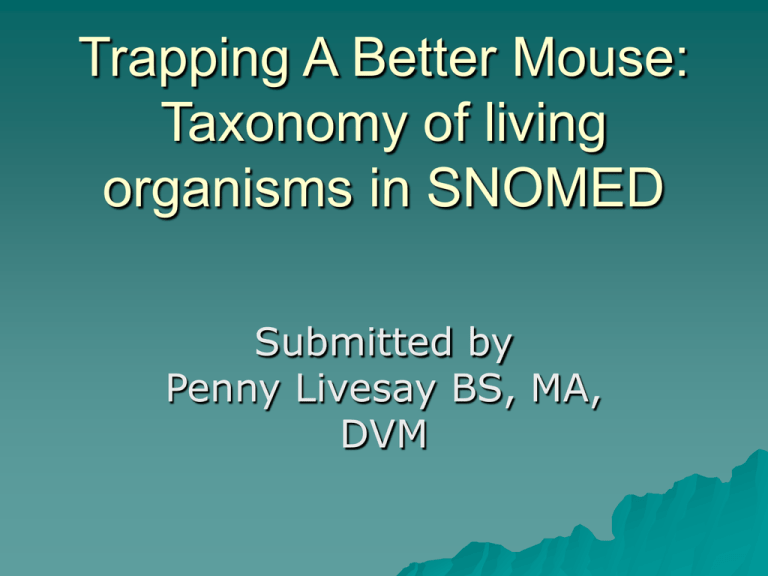Taxonomy (Living Organisms revisited)
advertisement

Trapping A Better Mouse: Taxonomy of living organisms in SNOMED Submitted by Penny Livesay BS, MA, DVM Proposal To organize SNOMED's taxonomy into a systematic and consistent Linnean hierarchy To remove all non-taxonomic information about living organisms from the taxonomic hierarchy To represent such information, when useful, reproducible, and retrievable, elsewhere in the nomenclature—for instance, by qualifier values. Methods All existing taxonomic terms are being reviewed and standardized according to the Integrated Taxonomic Information System (ITIS). Where ITIS is not yet complete, the Smithsonian mammalian taxonomy website is being used as a secondary reference. All organisms will be represented by their scientific names as FSNs. Common names of organisms will be given as descriptions where appropriate. Will not attempt to represent all known organisms now, but will create a skeletal representation at least to the level of subfamilies for all families. Additional genera and species will be added as time allows or as requested by What is ITIS? “A partnership of federal agencies formed to satisfy their mutual needs for scientifically credible taxonomic information” – USDA – EPA – Smithsonian Institute – Department of the Interior – Department of Commerce SNOMED's taxonomy of living organisms presently consists of: Linnean taxonomic terms (“Canis familiaris”) Common names for organisms (“Dog”) Non-taxonomic information – Use and Circumstances Laboratory fur-bearing animal – Pathogenicity Parasite, pyogenic bacterium – Life cycle stage of organisms Worm eggs Common names as FSNs: why is this a problem? Some organisms have many common names – Butorides virescens = green heron, greenbacked heron, little green heron, crab-catcher, fly-up-the-creek, green bittern, poke, shitepoke, skeow, skow, and swamp squaggin May be impossible to verify what organism is meant – Ex: Comte de Paris star frontlet (organism) ??? A single common name may refer to more than one species: – Ex: Yellowhammer (organism) MAY BE A Emberiza citrinella, MAY BE A Colaptes auratus Non-taxonomic terms in a taxonomic hierarchy: why is this a problem? In an ISA hierarchy, the relationships are "defining," that is, a subtype is always and necessarily a "kind of" its parent The present interpolation of non-taxonomic terms in a taxonomic hierarchy violates this convention, as these terms are often context-dependent rather than defining. An elephant may be a domestic animal in India; a dog may be a food animal in Korea – Question: Is a canary a “Wild bird--chordate” or a “Domestic fowl”? – Answer: Neither. It is Serinus canaria Work in progress Extending and correcting SNOMED’s taxonomic coverage of birds and mammals Retiring common names as FSN’s and referring them as synonyms to the appropriate scientific names Proposed further changes To represent contextual information about living organisms outside the taxonomic hierarchy – Contexts of domesticity (domestic, feral, wild) – Contexts of use (food, laboratory, companion, service, breeding, etc) – Contexts of life stage (oocyst, larva, spore, trophozooite, etc) – Contexts of medical significance (parasite, renotrophic organism, pathogen)??? Life, qualified? Qualifier values offer one possible means to convey non-taxonomic information about living organisms, just as qualifiers such as onsets, severities, or courses can be used to describe a disease An unqualified mink Mink ISA Domestic animal species, nonprimate (organism) A qualified mink Mustela vison (syn. Mink) ISA Genus Mustela Qualifier values – Context of use Fur-bearing animal Laboratory animal Etc. – Context of domestication Wild Domestic Feral What about “infectious agents”? The taxonomy of parasites, bacteria and other potentially pathogenic microorganisms is also a mixture of scientific names, common names, and contextual information Attempting to convey “contexts of pathogenicity” creates errors in logic: – Ex: Helminth ISA Parasite in SNOMED-but most helminths are not parasitic – Ex: Fungus ISA Infectious agent in SNOMED— but most fungi are not infectious





